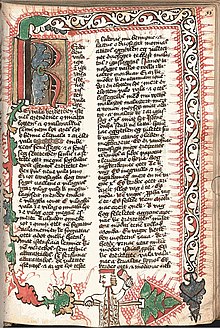Hussite Bible
The Hussite Bible (Hungarian: Huszita Biblia ) is a translation of the Bible into Hungarian from the 15th century. The surviving parts of the Bible are often called the Munich Codex , Vienna Codex or Apor Codex after their current storage locations .
history
Much of this translation of the Bible was done by the priests Bálint Újlaki and Tamás Pécsi between 1416 and 1435. Both were students at the University of Prague in 1399 and 1411, where they came into contact with the ideas of Jan Hus . They translated the Old Testament from the Vulgate and the New Testament from the Greek. Because they were persecuted, they had to flee east to the more liberal principality of Moldova in 1438 or 1439 . In Târgu Trotuș (Hungarian: Tatros) this Bible was finished and printed in 1466 by Georg Németi , a son of Emre Hensel.
A gospel book from 1466 and the calendars for the years 1416 to 1435 came into the possession of the diplomat, orientalist and humanist Johann Albrecht Widmanstetter (1506–1557). He had them bound together and the book came to Munich in 1558, the year the court library was founded. In addition to this Munich Code , the Vienna Code and the Apor Code have also been retained.
See also
Web links
- Website on the Hussite Bible and Hussite Spelling
- The oldest surviving Hungarian translation of the Gospels from 1466 is digitally accessible - Hussite Bible with calendar website ostbib.org, July 22, 2014
